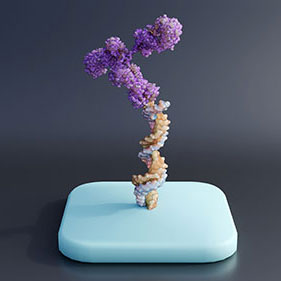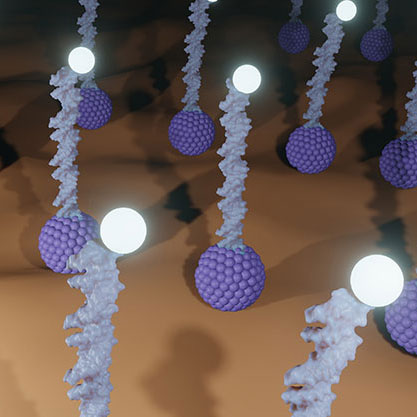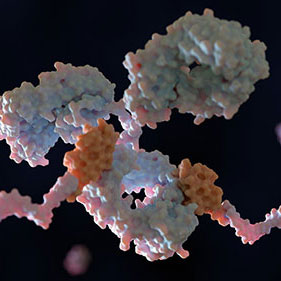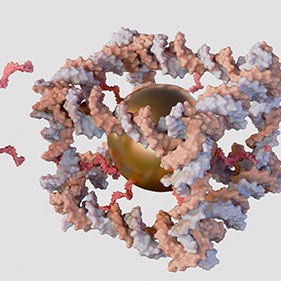In the rapidly evolving field of nucleic acid-based research, oligonucleotide conjugation has become an indispensable strategy to enhance molecular functionality, specificity, and delivery. BOC Sciences, with over two decades of specialized experience in biochemical solutions, provides scientifically rigorous and customizable oligonucleotide conjugation services tailored to meet the diverse needs of preclinical drug development, molecular diagnostics, and functional genomics. By leveraging state-of-the-art conjugation chemistries, proprietary linkers, and a robust understanding of biocompatibility, we ensure precise and reproducible modifications that meet the highest standards of quality and innovation.

Oligonucleotide conjugation is a transformative strategy that elevates the performance and versatility of synthetic nucleic acids in preclinical applications. By covalently attaching functional molecules to oligonucleotides, researchers gain precise control over pharmacodynamics, delivery efficiency, and functional readout. The importance of oligonucleotide conjugation is underscored by several critical advantages:
By integrating targeting specificity, delivery enhancement, and functional adaptability, oligonucleotide conjugation transforms synthetic nucleic acids from passive strands into intelligent molecular tools. For researchers aiming to push the boundaries of nucleic acid science, conjugation is not just beneficial—it is essential.
At BOC Sciences, we recognize the diverse and evolving needs of researchers working with miRNAs. To meet these demands, we provide a full spectrum of tailored miRNA synthesis services designed to support a variety of experimental objectives and biological models. Our offerings encompass chemically synthesized oligonucleotides, advanced chemical modifications, functional mimics and inhibitors, as well as vector-based delivery systems, enabling precise modulation of miRNA activity with optimal stability and specificity.
| Service Category | Conjugation Targets | Features | Applications | Prices |
| Peptide-Oligonucleotide Conjugation | Functional peptides (nuclear localization signals, mitochondrial targeting sequences), etc. | Linker flexibility and cleavage options allow tunable release profiles. |
| Inquiry |
| Antibody-Oligonucleotide Conjugation | Monoclonal antibodies (IgG1, IgG2a), Fab fragments, scFvs, etc. | Site-specific conjugation (e.g., to hinge-region cysteines) to retain antibody binding activity. |
| Inquiry |
| GalNAc-Oligonucleotide Conjugation | Triantennary N-acetylgalactosamine clusters, etc. | Rigid trivalent architectures to optimize receptor binding affinity. |
| Inquiry |
| Antibiotic-Oligonucleotide Conjugation | Vancomycin, Kanamycin, Tetracycline, Ciprofloxacin, etc. | Tailored linker chemistries maintain antibiotic bioactivity while ensuring oligonucleotide integrity and orientation. |
| Inquiry |
| Antioxidant-Oligonucleotide Conjugation | Glutathione (GSH), Ascorbic Acid, α-Tocopherol, etc. | Custom redox-sensitive linkers to enable GSH-triggered release. |
| Inquiry |
| Cell-Penetrating Peptide-Oligonucleotide Conjugation | TAT, Penetratin, Transportan, Pep-1, R9, etc. | Modular designs allow multivalency or cleavable peptide-oligo constructs. |
| Inquiry |
| Enzyme-Oligonucleotide Conjugation | Horseradish peroxidase (HRP), Alkaline phosphatase, β-galactosidase, etc. | Oriented conjugation to maintain enzymatic activity post-coupling. |
| Inquiry |
| Exosome-Oligonucleotide Conjugation | CD63-binding aptamers, lipid-anchored oligos, electroporated oligonucleotides, etc. | Integration strategies via covalent tagging or membrane insertion. |
| Inquiry |
| Fluorescent Molecule-Oligonucleotide Conjugation | FAM, Cy3, Cy5, Alexa Fluor 488/568/647, TAMRA, etc. | High-labeling efficiency with spacing control to avoid quenching. |
| Inquiry |
| Glycomimetic-Oligonucleotide Conjugation | Sialic acid analogs, mannose mimics, fucose derivatives, etc. | Precise stereochemistry control for ligand presentation. |
| Inquiry |
| Homing Peptide-Oligonucleotide Conjugation | RGD peptides (integrin targeting), NGR peptides (CD13 targeting), CREKA (tumor vasculature targeting), etc. | Dual payload conjugates (imaging + therapeutic) are available. |
| Inquiry |
| Lipids-Oligonucleotide Conjugation | Cholesterol, stearic acid, DSPE-PEG derivatives, etc. | Hydrophobic modifications improve serum stability and biodistribution. |
| Inquiry |
| Metal Chelates-Oligonucleotide Conjugation | DOTA, NOTA, DTPA, EDTA, etc. | Suitable for both diagnostic (PET/SPECT) and theranostic probes. |
| Inquiry |
| Nanoparticle-Oligonucleotide Conjugation | Gold nanoparticles, silica NPs, carbon dots, lipid NPs, etc. | Optimized surface density and orientation for hybridization performance. |
| Inquiry |
| Polymer-Oligonucleotide Conjugation | PEG, PCL, PLGA, PNIPAM, etc. | Biocompatible polymers tailored for degradation and release kinetics. |
| Inquiry |
| Protein-Oligonucleotide Conjugation | Transcription factors, nucleases, fluorescent proteins (e.g., GFP), albumin, etc. | Site-selective conjugation with preservation of native protein activity. |
| Inquiry |
| Quantum Dot-Oligonucleotide Conjugation | CdSe/ZnS QDs, graphene QDs, carbon QDs, etc. | Size-tunable fluorescence emission from blue to near-IR. |
| Inquiry |
| Small Molecule-Oligonucleotide Conjugation | Dexamethasone, doxorubicin, folate, biotin, etc. | Controlled drug-to-oligo ratios with validated release profiles. |
| Inquiry |
| Stimulus-Responsive Oligonucleotide Conjugation | pH, ROS, redox potential, enzymes (e.g., MMPs), etc. | Modular responsive linkers designed for tumor, inflammatory, or intracellular environments. |
| Inquiry |
| Virus-Like Particle-Oligonucleotide Conjugation | Qβ VLP, MS2 VLP, plant-based VLPs, etc. | High-density surface conjugation or encapsulation options. |
| Inquiry |
At BOC Sciences, we recognize that successful conjugation depends heavily on the nature and integrity of the oligonucleotide itself. That’s why we provide a broad spectrum of oligonucleotide types tailored for diverse research applications and conjugation strategies. Whether your project focuses on gene silencing, molecular imaging, cell targeting, or delivery optimization, our synthesis and customization capabilities ensure the optimal oligo format for your application.
The success of oligonucleotide conjugation hinges not only on the conjugate chemistry but also on the compatibility, purity, and customization of the oligonucleotide itself. At BOC Sciences, we combine industry-grade oligo manufacturing with advanced functionalization, delivering fully conjugation-ready oligonucleotides for your preclinical innovation.
Engage with our seasoned experts for advanced, scalable, and customized conjugation solutions
— designed to meet the most stringent scientific demands.
BOC Sciences provides a diverse portfolio of chemically robust and biologically compatible conjugation strategies designed to precisely link oligonucleotides with a broad array of functional moieties. Our oligonucleotide conjugation methods are optimized for high efficiency, reproducibility, and scalability to meet the exact demands of preclinical R&D in biotechnology, diagnostics, and drug development.
This is a widely used and highly reliable method to link oligonucleotides to molecules bearing carboxyl or amine groups. By incorporating amino-modified oligonucleotides, we facilitate covalent attachment to:
This method provides a stable and bioresistant linkage, well-suited for in vivo studies.
The thiol-maleimide click reaction is a selective and biocompatible approach used extensively for attaching oligos to:
Thiol-modified oligonucleotides react specifically with maleimide-functionalized molecules under mild conditions, preserving the activity of both the oligo and the conjugate.
Copper(I)-catalyzed azide-alkyne cycloaddition (CuAAC) and strain-promoted azide-alkyne cycloaddition (SPAAC) are efficient “click” methods for oligonucleotide conjugation. Features include:
These methods are ideal for constructing multifunctional or modular oligonucleotide conjugates.
Reversible disulfide linkages allow cleavable conjugation, ideal for:
We offer oligonucleotides modified with thiol groups that can form disulfide bonds with appropriate targets such as peptides or proteins.
Using 1-Ethyl-3-(3-dimethylaminopropyl)carbodiimide (EDC) and N-hydroxysuccinimide (NHS), we enable direct activation of carboxyl groups to form amide bonds with primary amines on oligonucleotides or payloads. This method is:
These bioorthogonal reactions between aldehyde/ketone-modified oligonucleotides and aminooxy/hydrazide groups yield:
This method is often selected for conjugation with biomolecules sensitive to harsh chemical environments.
A commonly used approach to conjugate oligonucleotides to amine-bearing ligands, proteins, or polymers. The high reactivity and aqueous compatibility of NHS esters make this method particularly suitable for:
One of the strongest known non-covalent interactions, this method enables:
We provide both biotinylated oligonucleotides and streptavidin-functionalized carriers for customized applications.
We use water-soluble carbodiimides to activate carboxyl-containing molecules, enabling direct conjugation to amine-modified oligos. This is a preferred approach when:
Where gentle conditions and site specificity are paramount, we offer enzymatic labeling using ligases or transferases. These include:
This approach supports applications in biosensing, enzymatic amplification systems, and bioconjugate vaccines.
For applications demanding spatial and temporal control, we offer UV-triggered conjugation using photo-crosslinkable moieties (e.g., aryl azides, diazirines). This is suitable for:
We also support on-resin oligonucleotide conjugation, allowing direct synthesis of oligo conjugates on a solid support. This approach enables:
BOC Sciences delivers full-spectrum conjugation services with expert consultation, ensuring that your selected oligonucleotide type is paired with the optimal conjugation method for your biological target, delivery platform, and analytical endpoint. Our methods are validated and scalable—ready to transition from proof-of-concept to advanced preclinical models.
BOC Sciences employs a rigorous and highly controlled workflow to ensure the production of oligonucleotide conjugates with superior quality, reproducibility, and functionality. Each step integrates advanced chemistry and analytical techniques to meet the precise demands of preclinical research.
Through this meticulous and integrated process, BOC Sciences ensures that every oligonucleotide conjugate meets the highest standards for preclinical research and development applications.
Selecting BOC Sciences for oligonucleotide conjugation ensures a partnership grounded in scientific rigor, innovation, and customer-focused precision. Our service advantages distinctly position us as a leader in the preclinical bioconjugation landscape:
Advanced Technical Expertise: Leveraging over 20 years of experience, we apply state-of-the-art conjugation methods—including click chemistry and site-specific techniques—to deliver stable, functional oligonucleotide conjugates.
Customized Conjugation Strategies: Each project is designed to fit your unique experimental needs, optimizing linker chemistry and conjugate properties for enhanced target engagement and delivery.
Wide Range of Conjugation Options: From antibodies and peptides to nanoparticles and stimulus-responsive groups, our comprehensive portfolio supports diverse research applications, streamlining your workflow under one provider.
Strict Quality Control: Our rigorous purification and characterization processes—using HPLC, mass spectrometry, and spectroscopy—ensure consistent purity, structure, and conjugation efficiency.
Efficient Integrated Workflow: Seamless coordination from oligonucleotide synthesis to final conjugation accelerates turnaround times, enabling faster project progress without sacrificing quality.
Through this combination of scientific mastery, bespoke customization, comprehensive analytical rigor, and dedicated client service, BOC Sciences stands as the premier choice for oligonucleotide conjugation services designed to elevate your preclinical research capabilities.
Oligonucleotide conjugation profoundly enhances the functionality and versatility of oligonucleotides, enabling their application across a wide spectrum of advanced scientific and therapeutic research areas. The conjugation services offered by BOC Sciences empower researchers to tailor oligonucleotide molecules to meet specific experimental needs, driving innovation and improving efficacy in preclinical studies.

Conjugating oligonucleotides with targeting ligands such as peptides, antibodies, or GalNAc enables precise delivery to specific cell types or tissues. This targeted approach improves cellular uptake and reduces off-target effects, crucial for gene silencing, antisense, or RNA interference therapies. For example, GalNAc-oligonucleotide conjugates have shown enhanced liver-specific delivery, significantly boosting therapeutic index in preclinical models.

The use of cell-penetrating peptides (CPPs) or lipid conjugates dramatically improves the internalization efficiency of oligonucleotides. These conjugates facilitate endosomal escape and intracellular trafficking, overcoming major barriers in nucleic acid delivery. This application is critical for in vitro and in vivo studies requiring robust gene modulation with high efficiency and minimal cytotoxicity.

Fluorescent molecule or quantum dot conjugation to oligonucleotides enables real-time tracking and imaging of nucleic acid interactions at the cellular and molecular level. These conjugates serve as powerful tools in molecular diagnostics, enabling visualization of target binding, cellular localization, and dynamics within biological systems.

Conjugation with metal chelates or nanoparticles facilitates the development of highly sensitive biosensors for detecting nucleic acids, proteins, or small molecules. These conjugates are applied in assays with improved signal-to-noise ratios and enable quantitative analysis of biomarkers relevant to disease research and drug development.

Stimulus-responsive oligonucleotide conjugates allow for triggered release under specific conditions such as pH changes, enzymatic activity, or light exposure. This application is particularly valuable in controlled drug delivery systems, where precise spatiotemporal control of oligonucleotide activity enhances therapeutic outcomes.

Virus-like particle (VLP) or exosome conjugation with oligonucleotides offers advanced platforms for vaccine delivery and immune system modulation. These conjugates can enhance antigen presentation and elicit targeted immune responses, serving as innovative tools in immunotherapy and prophylactic vaccine research.

Protein-oligonucleotide or enzyme-oligonucleotide conjugates are instrumental in dissecting biomolecular interactions and mechanisms. Such conjugates facilitate site-specific labeling, activity modulation, or stabilization of nucleic acid-protein complexes, advancing structural biology and enzymology research.

Conjugation with glycomimetic ligands or small molecules enables the design of oligonucleotides with enhanced receptor specificity and affinity. This approach is vital for targeting cell surface receptors implicated in disease, aiding in the development of novel therapeutic agents with improved bioavailability and reduced toxicity.
Through these diverse applications, BOC Sciences' oligonucleotide conjugation services empower clients to expand the capabilities of nucleic acid-based research tools and therapeutics, accelerating discovery and enhancing preclinical development success.
We offer conjugation services for a wide range of oligonucleotides, including DNA, RNA, siRNA, antisense oligonucleotides, aptamers, and modified backbones (e.g., phosphorothioate, 2'-O-methyl, LNA). Our service is fully customizable based on your research objectives, allowing precise conjugation of functional groups or biomolecules tailored to your application.
Absolutely. We support both customer-supplied oligonucleotides and partner molecules, or we can synthesize the necessary components in-house using our cGMP-compliant preclinical manufacturing platform. We accommodate flexible starting materials while maintaining full control over conjugation parameters.
All conjugates undergo stringent quality control processes, including HPLC, mass spectrometry, and, when needed, gel electrophoresis or UV-Vis analysis. We provide a comprehensive Certificate of Analysis (CoA) with every batch, ensuring batch-to-batch consistency, high purity, and conjugation fidelity.
BOC Sciences is fully equipped to support both small-scale exploratory research and large-scale conjugate production. We offer scalable synthesis capabilities, from milligram to multi-gram quantities, with consistent quality to meet the needs of research institutes, biotech firms, and pharmaceutical companies alike.
We adhere to strict confidentiality and intellectual property protection protocols. Non-disclosure agreements (NDAs) are available upon request, and all projects are executed under secure, client-dedicated conditions to safeguard sensitive data and materials.

